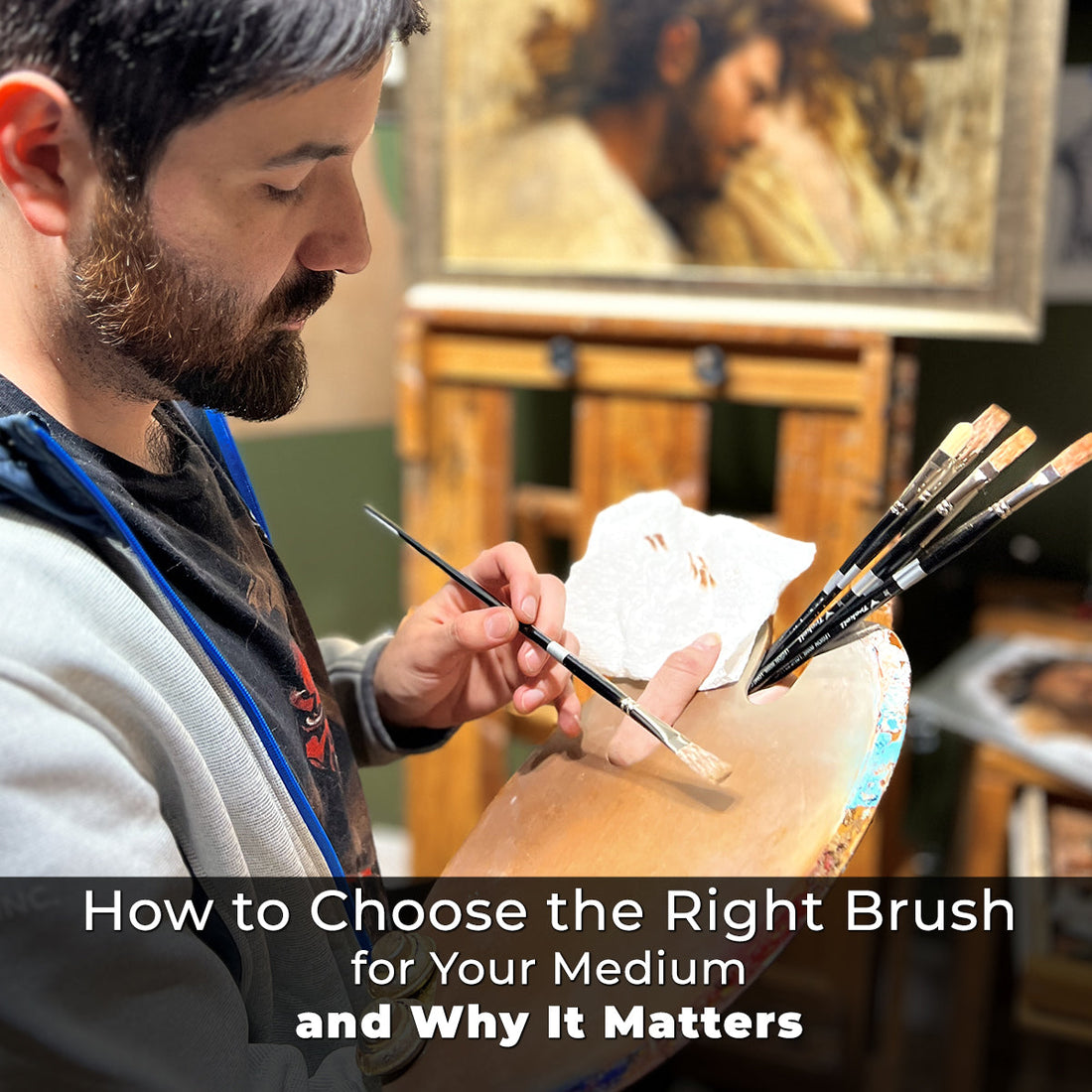Every brushstroke tells a story, so choosing the right brush for your medium is crucial. Vincent van Gogh's oil paint brushwork is that of a swirling storm with emotion sculpted in paint. David Hockney's acrylic brushstrokes are flat and graphic. In contrast, J.M.W. Turner's watercolors feature gentle, cloud-like sweeps across the canvas. The right paintbrush isn't about size, but also about control, texture, and getting the most out of your medium of choice. Your brush is your top tool. It helps you turn your ideas into reality. You can use it with thick oils, fast-drying acrylics, or flowing watercolors.
Let’s take a closer look at the best brushes for each medium.

For Oil Painting: Go Bold, Go Durable
Rembrandt created texture and depth within the shadows of his oil paintings. This type of brushwork requires brushes capable of handling thick paint and maintaining their shape. Treckell offers brushes with natural and synthetic options. These are perfect for handling the weight of your medium, with softer, springier options for detail work and glazing.
Ideal Brush Types:
● Filbert – Our Filbert and Long Filbert brushes provide the control desired when blending edges with smooth curves. These may be the preferred brushes for figurative rendering.
● Flat—If you are looking for a strong brush that can handle the weight of oil and produce confident blocks of color, try our Flat or Long Flat brushes. Your typical length brushes are great for up-close work, while long brushes are best for working at a distance.
● Round—For detailed work and drawing-like control, try our Round Brush. Create stunning fine lines and curved strokes. Apply various levels of pressure to help you create different effects.
Trekell Tip: Oils are slow-drying, so use durable brushes to push and sculpt paint.

For Acrylic Painting: Versatility Is Key
People know Bridget Riley for her precise acrylics. They move like hypnotic waves. The clean, sharp edges seem anti-brushstroke. Even invisible marks can leave a strong impression. Amy Sherald's portraits have a matte finish. They feature smooth, even layers of acrylic paint. You can hardly see any brushstrokes. Her restraint makes the color do the talking, with calm and deliberate visual power. You may consider the following to achieve this effect while using acrylic paints. Stiff synthetic bristles can handle acrylic’s fast-drying nature without becoming misshapen, and nylon or taklon are smooth, resilient, and easy to clean.
Ideal Brush Types:
● Angle—If you want to create clean lines, Angle Brushes are the best tool for the job. Trekell offers a variety of brush sizes that are perfect for edges and those hard-to-reach, tight corners.
● Bright—The efficiency of the flat ferrule and short bristles makes the Bright Brush excellent for your creative endeavors in creating bold, textured marks. The ability to precisely apply paint is beneficial when a medium such as acrylic allows quick, controlled strokes.
● Fan—The perks of using a Fan Brush come from its ability to create delicate textures, soft blend styles, and add dimensions to your work. Trekell's selection of various Fan Brush ferrule sizes creates endless opportunities for your artwork's potential.
Trekell Tip: Acrylics dry fast, so look for brushes that won’t fray or clog with paint. Make sure to exclusively use our line of brushes created explicitly for acrylic painting.

For Watercolor Painting: Soft Touch, Smooth Flow
John Singer Sargent's watercolor brushwork is bold and exhibits an effortless quality. His mastery lies in making complex subjects appear simple at first glance. Meanwhile, Georgia O'Keeffe's watercolors have soft edges where brushstrokes feel composed. Watercolor and gouache are great choices because they are fluid and forgiving. Using the right brushes makes a big difference when working with these media.
Ideal Brush Types:
● Round—The Round Brush is the watercolor MVP for washes and fine detail. The round tip holds water and pigment, ideal for maximum coverage on the page. This allows you to build up the layers of your medium as you see fit.
● Oval– The rounded bristles and flat ferrules combine to produce a stunning soft edge. These features of the Oval Brush can be handy for laying in pigment or water and absorbing excess media.
● Rigger – The tiny tip of the Rigger Brush is crucial for creating long, continuous lines and calligraphic details. When used to enhance finishing details, the results produced by this brush add a new level of sophistication to your work.
Trekell Tip: Watercolor requires fluid motion and pigment control. Look for brushes that hold their shape when wet. Try our collection of watercolor brushes for beginner-to-pro-level results.

Clean your brushes with attention to detail, regardless of the medium. Oil brushes need solvent or oil-based cleaners, while acrylic and watercolor brushes only need water and mild soap. Store your brushes upright to prevent the bristles from bending and to maintain their shape. Also, organize your brushes by medium to avoid mixing, which can cause residue and harm your paint or surface. Invest in your brush collection and allow your brush to reflect your vision. Your art deserves the right tools. Use Trekell's brushes to layer glazes in oils, create texture with acrylics, or apply washes in watercolor—mix and match Trekell’s brushes to complement your medium and style best.



